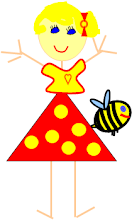Both structured and unstructured writing opportunities can benefit preschoolers but it is important to understand the difference and to know what is age appropriate.
Unstructured Writing Opportunties
Providing a writing center or writing tools on a table that preschoolers are free to explore are examples of unstructured writing opportunities. As very young preschoolers are developing their fine motor skills, they need the freedom to explore writing or coloring without all the rules. Writing should be viewed as a fun and interesting activity to explore.
Older preschoolers also need unstructured opportunities to color and write but they will begin to express an interest in being able to create specific objects. Older preschoolers may ask their teacher to help them draw a person, dog, or apple. Requests like these are unstructured opportunties to give preschoolers tips and skills to help them improve on their writing skills. Teaching a child how to draw a circle then add a line on the top to create an apple helps the preschooler to begin understanding how they can create symbols and objects that are familiar to them and how those symbols tell stories.
Structured Writing Opportunities
Structured writing opportunties are specific lessons or activities that focus on children's writing abilities or skills. Often times, teachers will select a specific worksheet with dotted lines to trace and other times, the teacher will have preschoolers listen and follow directions to create a specific object.
Structured writing opportunities can improve writing skills but teachers must be sensitive to the abilities of their students. Toddlers, for example, would not benefit from tracing a circle on a sheet of paper since toddlers are still working on their ability to hold a crayon. However, a toddler would benefit from the opportunity to scribble on a blank sheet of paper.
Example of a structured drawing activity
The Latest on Teach Preschool!
Thursday, November 5, 2009
Providing preschoolers with structured and unstructured opportunities to write
The teacher chose to help her students draw a cat. She demonstrated each step shown above to her Kindergarten class and the children worked to draw their own cat one step at a time.
Each child was given a blank sheet of paper and told to print their name at the top.
The teacher demonstrated how to make a circle, and the children drew their own circle.
Subscribe to:
Post Comments (Atom)


0 comments:
Post a Comment